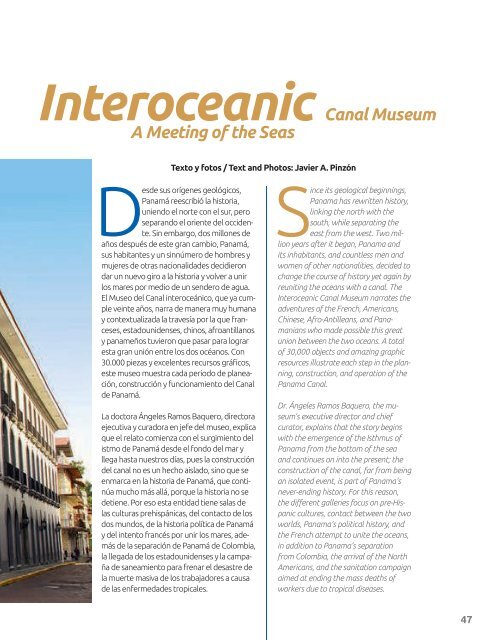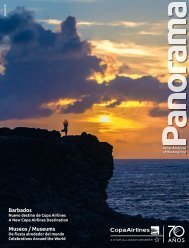Create successful ePaper yourself
Turn your PDF publications into a flip-book with our unique Google optimized e-Paper software.
Interoceanic Canal Museum<br />
A Meeting of the Seas<br />
Texto y fotos / Text and Photos: Javier A. Pinzón<br />
Desde sus orígenes geológicos,<br />
Panamá reescribió la historia,<br />
uniendo el norte con el sur, pero<br />
separando el oriente del occidente.<br />
Sin embargo, dos millones de<br />
años después de este gran cambio, Panamá,<br />
sus habitantes y un sinnúmero de hombres y<br />
mujeres de otras nacionalidades decidieron<br />
dar un nuevo giro a la historia y volver a unir<br />
los mares por medio de un sendero de agua.<br />
El Museo del Canal interoceánico, que ya cumple<br />
veinte años, narra de manera muy humana<br />
y contextualizada la travesía por la que franceses,<br />
estadounidenses, chinos, afroantillanos<br />
y panameños tuvieron que pasar para lograr<br />
esta gran unión entre los dos océanos. Con<br />
30.000 piezas y excelentes recursos gráficos,<br />
este museo muestra cada periodo de planeación,<br />
construcción y funcionamiento del Canal<br />
de Panamá.<br />
La doctora Ángeles Ramos Baquero, directora<br />
ejecutiva y curadora en jefe del museo, explica<br />
que el relato comienza con el surgimiento del<br />
istmo de Panamá desde el fondo del mar y<br />
llega hasta nuestros días, pues la construcción<br />
del canal no es un hecho aislado, sino que se<br />
enmarca en la historia de Panamá, que continúa<br />
mucho más allá, porque la historia no se<br />
detiene. Por eso esta entidad tiene salas de<br />
las culturas prehispánicas, del contacto de los<br />
dos mundos, de la historia política de Panamá<br />
y del intento francés por unir los mares, además<br />
de la separación de Panamá de Colombia,<br />
la llegada de los estadounidenses y la campaña<br />
de saneamiento para frenar el desastre de<br />
la muerte masiva de los trabajadores a causa<br />
de las enfermedades tropicales.<br />
Since its geological beginnings,<br />
Panama has rewritten history,<br />
linking the north with the<br />
south, while separating the<br />
east from the west. Two million<br />
years after it began, Panama and<br />
its inhabitants, and countless men and<br />
women of other nationalities, decided to<br />
change the course of history yet again by<br />
reuniting the oceans with a canal. The<br />
Interoceanic Canal Museum narrates the<br />
adventures of the French, Americans,<br />
Chinese, Afro-Antilleans, and Panamanians<br />
who made possible this great<br />
union between the two oceans. A total<br />
of 30,000 objects and amazing graphic<br />
resources illustrate each step in the planning,<br />
construction, and operation of the<br />
Panama Canal.<br />
Dr. Ángeles Ramos Baquero, the museum’s<br />
executive director and chief<br />
curator, explains that the story begins<br />
with the emergence of the Isthmus of<br />
Panama from the bottom of the sea<br />
and continues on into the present; the<br />
construction of the canal, far from being<br />
an isolated event, is part of Panama’s<br />
never-ending history. For this reason,<br />
the different galleries focus on reHispanic<br />
cultures, contact between the two<br />
worlds, Panama’s political history, and<br />
the French attempt to unite the oceans,<br />
in addition to Panama’s separation<br />
from Colombia, the arrival of the North<br />
Americans, and the sanitation campaign<br />
aimed at ending the mass deaths of<br />
workers due to tropical diseases.<br />
47



